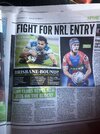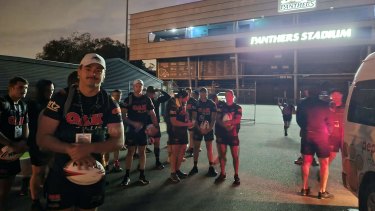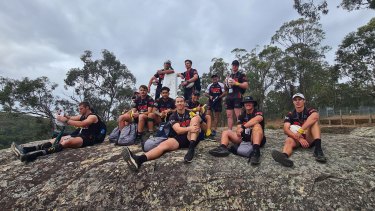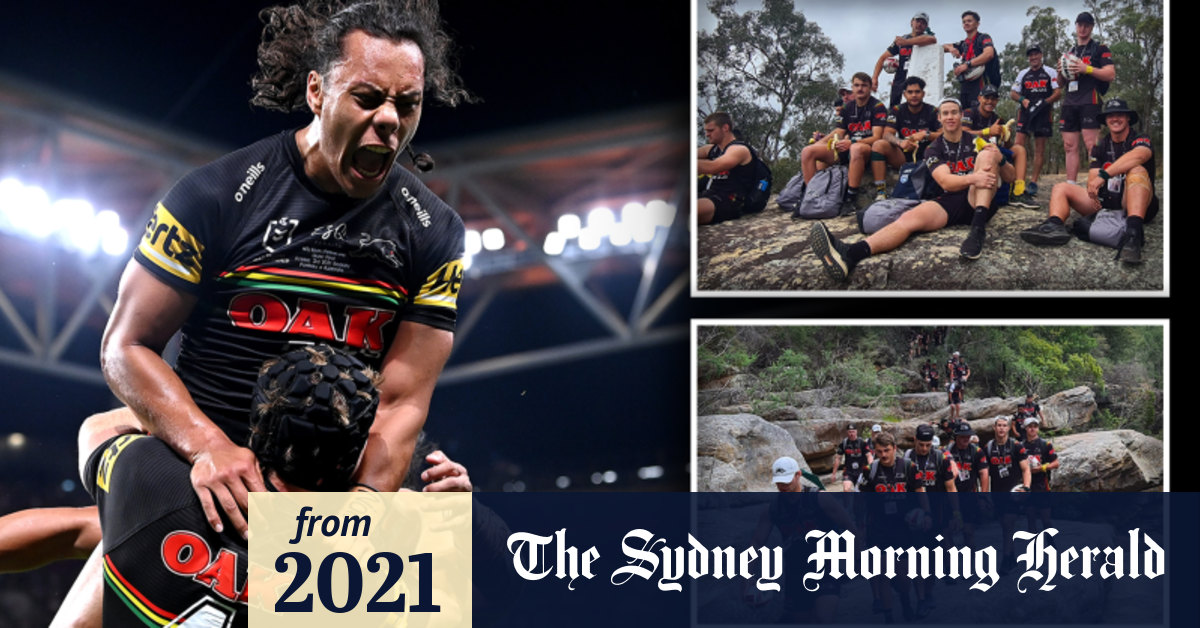This is a better story.
The football factory: The 24-hour walks and stadium sleepouts shaping Penrith’s NRL dynasty
October 9, 2021 — 5.00am
Through a guard of honour formed by players who are getting ready for their game, a group of sleep-deprived and exhausted teenagers shuffle through one by one.
They’ve been walking laps inside the perimeter of Panthers Stadium for the last 24 hours, only breaking every three hours or so to be asked about their values: what is really driving you?
The sun has gone down, it’s come back up again and soon will go down too. By the end, each member of the group of budding Penrith stars, about to enter the club’s system as 14 and 15-year-olds, is estimated to have walked about 63 or 64 kilometres.
“We talk about it being like walking from Bondi to Penrith, from the coast to the river,” says Brogan Mulhall, the man behind Penrith’s community arm, Panthers On The Prowl.
“The older boys make a guard of honour for them as they kick-off their games. It’s a powerful linkage to show, ‘hey, you’re part of this fabric and this is now your responsibility’.”
If you want to know the secrets behind rugby league’s best football factory, then the balmy nights at Panthers Stadium are a pretty good place to start.
Panthers juniors on a 24-hour walk around their stadium.Credit

enrith Panthers
From the sleepless walks around the ground to actually sleeping overnight in swags in the in-goal of their protected patch, the Panthers’
Building Young Men program is already moulding the next Nathan Cleary and Isaah Yeo to ensure they remain an NRL powerhouse.
There are army-style camps along the river at Yarramundi, where players carry footballs and are asked to write down their values. They’re then presented back to the players in a glass perspex case on a harbour cruise. And vulnerability sessions where players congregate in a little circle and talk openly about their life journey.
It’s all part of the process to become a Panther, and perhaps a reason why a wounded side tackled their way to a historic grand final win last Sunday night despite scoring only six tries in four finals games.
“Some of those moments were the mental game in action,” Mulhall says. “We saw that, the determination and the resilience. I look at that team and think, ‘that’s a team’. It’s bound by a lot of those values.
“For me, this is the next edge; building sound and psychologically robust players on and off the field. That’s the extra one per cent. You saw that in the grand final. Even if [Adam] Reynolds kicked that goal, I would have put money on the boys bouncing back and putting more points on the board.”
Only a few days after their title triumph over the Rabbitohs last Sunday night, Penrith’s smartest football minds met over Zoom and started finalising their under-age squads for next season.
Each name will be placed on one of two whiteboards, either in the office of their pathways coaches or that of general manager Matt Cameron. Almost daily a name is shuffled up or down, contingent on training and matchday performances. Formal meetings and casual lunches are held around the whiteboard. Veteran recruitment guru Jim Jones will often just stand and stare at it while drinking a cup of coffee.
The whiteboard projection is always for the next three years, meaning every time a fan asks, ‘why did they release a player like Josh Mansour?’, the reason is usually found in a bunch of magnets with kids names on them below ready to step into the void.
Panthers juniors undertake a development program in the bush.Credit

enrith Panthers
Cameron has another magnet on his whiteboard:
200 games, not 20. No Penrith player has cracked the mark since Luke Lewis in 2012 (although Yeo will be on track for it in 2023).
“The hidden message for us is about maximising a player’s potential,” Penrith’s elite development manager Ben Harden says. “If there’s going to be a zero gamer, can we make him a 20 gamer? If he’s going to be a great Flegg player, can we make him a great Cup player? Can we make a 50 gamer [in the NRL] a 300 gamer?
“The next part of my thought process is ... we’re not even looking for first-graders any more, we’re looking for premiership players or top four players.
“Four years ago I was trying to produce young players to handle an NRL pre-season for a team that was on the fringe of the top eight, squeezing into maybe week two of the finals. Now it’s a whole level of expectation. The Roosters and Storm have been doing this for 10 years. It’s only the end of the beginning for us when you see what the Roosters and Storm have been able to do.
“Now we’re asking: are you just there and holding your gloves up, or can you play like Matt Burton at centre in your 25th or 26th game of a season and can you deliver? Izack Tago debuted off the back of COVID in a top four side and didn’t look out of place.
“We’re not perfect by any stretch and the squeeze on the cap is going to make us produce younger players at a higher level quicker, but it’s a whole new level of expectation.”
That expectation is going to be built quickly through mindset. Harden says pathways players are asked to complete extra conditioning work individually on a day off to allow for further psychological training on club days.
To keep the spirits up of their Jersey Flegg and SG Ball players this year after their competitions were cancelled due to COVID, Mulhall and wellbeing manager Kevin Kingston organised weekly video sessions with NRL players in the Queensland biosecurity bubble.
From Cleary and James Fisher-Harris to Tago and Taylan May, the club’s best players resolved to make time for the budding stars who can’t train or play together knowing how vulnerable they have been.
“We’ve all been young men, and when I was their age it was soft if you showed weakness or got emotional,” Harden says. “It’s just not right. Everyone just accepts uniqueness here.
“This [mindset work] is more important than just doing some running. We thought that had to be our main focus coming out of COVID. You can’t pretend it hasn’t had an impact on them. We want to address it, learn from it and take positives out of it.”
In some respects, the Panthers were always going to win an NRL grand final again.
The decade-long project started when Phil Gould returned to the club and Cameron presented a document to the Panthers board outlining his quest to build from within. It was called Project 2015.
Cameron recalls in the early days identifying NSW’s central west as an area the Panthers had to invest in. He went out to Bathurst and took a photo of a bunch of 13- and 14-year-old school kids in front of the Carrington Park scoreboard at a local clinic. The second photo was of 15- and 16-year-olds.
They came back to Sydney, blew the photos up on a computer and realised not one kid was wearing a Panthers jersey. They knew it needed to change, and the board insists it will keep investing in the game, only bringing players to Penrith when they’re ready.
“I always say I’d hate to pull the kid to Penrith and he never got a chance to play for Western Division, then 10 years from now he’s sitting at the pub with his mates and they’re saying, ‘what about that day?’ And the kid goes, ‘well, I never got to experience that because I was at Penrith’,” Cameron says.
And by the time they arrive, they’ve been around the block a few times.
The Panthers had been building to their historic NRL title for years. But what makes their pathways systems so good?

www.smh.com.au





 enrith Panthers
enrith Panthers
